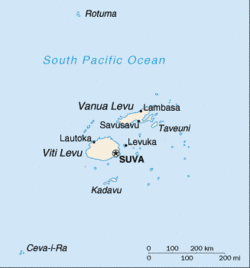Welcome to the Virtual Education Wiki ~ Open Education Wiki
Fiji
Partners situated in Fiji
Fiji in a nutshell
(sourced from http://en.wikipedia.org/wiki/Fiji)
Fiji(Fijian: Matanitu ko Viti; Fijian Hindustani: फ़िजी), officially the Republic of the Fiji Islands (Fijian: Matanitu Tu-Vaka-i-koya ko Viti; Fijian Hindustani: फ़िजी द्वीप समूह गणराज्य, fiji dvip samooh ganarajya), is an island nation in the South Pacific Ocean east of Vanuatu, west of Tonga and south of Tuvalu. The country occupies an archipelago of about 322 islands, of which 106 are permanently inhabited, and 522 islets. The two major islands, Viti Levu and Vanua Levu, account for 87% of the population.
The population is around 850,000.
The capital is Suva.
Fiji is divided into Four Major Divisions: Central, Eastern, Northern and Western. These divisions are further divided into 14 provinces.
Fiji, endowed with forest, mineral, and fish resources, is one of the more developed of the Pacific island economies, though still with a large subsistence sector. Natural resources include timber, fish, gold, copper, offshore oil potential, hydropower. Fiji experienced a period of rapid growth in the 1960s and 1970s but stagnated in the 1980s. Economic liberalization in recent years created a boom in the garment industry and a steady growth rate despite growing uncertainty of land tenure in the sugar industry. The expiration of leases for sugar cane farmers (along with reduced farm and factory efficiency) has led to a decline in sugar production despite a subsidized price.
Urbanization and expansion in the service sector have contributed to recent GDP growth. Sugar exports and a rapidly growing tourist industry — with 430,800 tourists in 2003[31] and increasing in the subsequent years — are the major sources of foreign exchange. Fiji is highly dependent on tourism for revenue. Sugar processing makes up one-third of industrial activity. Long-term problems include low investment and uncertain property rights. The political turmoil in Fiji has had a severe impact on the economy, which shrank by 2.8% in 2000 and grew by only 1% in 2001.
Fijian is an Austronesian language of the Malayo-Polynesian family spoken in Fiji. It has 350 000 first-language speakers, which is less than half the population of Fiji, but another 200,000 speak it as a second language. The 1997 Constitution established Fijian as an official language of Fiji, along with English and Hindustani, and there is discussion about establishing it as the "national language", though English and Hindustani would remain official.
The Fiji Islands developed many languages, some similar and some very different. Missionaries in the 1840s chose the language of one island off the southeast of the main island of Viti Levu, to be the official language of Fiji. Standard Fijian is based on the language of Bau, which is an East Fijian language. There are many other dialects that make up the West Fijian languages including dialects spoken in the Nadroga/Navosa and those of the western island groups and provinces.
Fiji education policy
Fiji education system
Higher education
Universities in Fiji
(this is an important section)
Polytechnics in Fiji
Higher education reform
The Bologna Process
(very important for European countries)
Administration and finance
Quality assurance
Fiji HEIs in the information society
Towards the information society
Information society strategy
Virtual Campuses in HE
Interesting Virtual Campus Initiatives
(another very important section)
Interesting Programmes
Re.ViCa Case-study
Lessons learnt
References
(try to add one or two)
